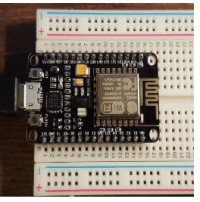RFID system with on-line management - NodeMCU

Article on RFID door opener with wifi connectivity, encrypted transfer, MySQL database and web interface.
Today, I'd like to introduce the system I've been developing last week.
I made an RFID system to open the electronic door. The system is built on components for Arduino, ie a 13.56MHz RC522 card reader and keypad, compatible cards and keychains. The reader is able to read the ISO / IEC 14443 A standard cards. This standard also works on ISICs, ATMs, or busses, and can also be read and used for such a project.
By reader, I read the MAC address of the cards (it can also be read and write in the memory of the cards and the key, which is mostly 1kB or 4kB), the MAC addresses I read to convert to a specific DEC format. In the role of the microcontroller for processing and sending data, I used a NodeMCU board that has wifi connectivity and is more than adequate for this purpose. The system is suitable for halls, corporate entrance gates, electronic doors and similar applications.
The task of NodeMCU is to send data to the web backend whenever it logs the card and opens or unlocks the door based on the retrieved response from the webserver (by default ACCEPT / DENY). Besides the classic mechanism with a handle, the door also includes a special elmg. a tongue that is opened by the microcontroller for a certain time after a successful response from the webserver. The outer side of the door is a ball, on the other side a handle that is also connected to the tongue. Therefore, it is not necessary to install two readers or the like.
Datas are sent to the server and processed in .php backend. All cards that have been enclosed are archived, and from the administration interface, where real-time entries to the object can be seen, it is possible to authorize or authorize or de-authorize the card. Real-time data update is implemented by AJAX call. The entire web interface is hidden behind the security login for the administrator or the card manager who is responsible.
The system is fast and the rules for the cards for its authorization, or the deauthorization can be done comfortably from anywhere and the rule is immediately applicable. It is therefore very easy to manage this system even for lay people. In the case of a Web site / Internet failure, it is always possible to enter the object with a key that can tighten the tongue along with the tongue of the lock mechanism.
Reader Datasheet RC522: https://www.nxp.com/docs/en/data-sheet/MFRC522.pdf
Datasheet NodeMCU (ESP8266): http://www.handsontec.com/pdf_learn/esp8266-V10.pdf
I made an RFID system to open the electronic door. The system is built on components for Arduino, ie a 13.56MHz RC522 card reader and keypad, compatible cards and keychains. The reader is able to read the ISO / IEC 14443 A standard cards. This standard also works on ISICs, ATMs, or busses, and can also be read and used for such a project.
By reader, I read the MAC address of the cards (it can also be read and write in the memory of the cards and the key, which is mostly 1kB or 4kB), the MAC addresses I read to convert to a specific DEC format. In the role of the microcontroller for processing and sending data, I used a NodeMCU board that has wifi connectivity and is more than adequate for this purpose. The system is suitable for halls, corporate entrance gates, electronic doors and similar applications.
The task of NodeMCU is to send data to the web backend whenever it logs the card and opens or unlocks the door based on the retrieved response from the webserver (by default ACCEPT / DENY). Besides the classic mechanism with a handle, the door also includes a special elmg. a tongue that is opened by the microcontroller for a certain time after a successful response from the webserver. The outer side of the door is a ball, on the other side a handle that is also connected to the tongue. Therefore, it is not necessary to install two readers or the like.
Datas are sent to the server and processed in .php backend. All cards that have been enclosed are archived, and from the administration interface, where real-time entries to the object can be seen, it is possible to authorize or authorize or de-authorize the card. Real-time data update is implemented by AJAX call. The entire web interface is hidden behind the security login for the administrator or the card manager who is responsible.
The system is fast and the rules for the cards for its authorization, or the deauthorization can be done comfortably from anywhere and the rule is immediately applicable. It is therefore very easy to manage this system even for lay people. In the case of a Web site / Internet failure, it is always possible to enter the object with a key that can tighten the tongue along with the tongue of the lock mechanism.
Reader Datasheet RC522: https://www.nxp.com/docs/en/data-sheet/MFRC522.pdf
Datasheet NodeMCU (ESP8266): http://www.handsontec.com/pdf_learn/esp8266-V10.pdf



Diskussion (1 Kommentar)